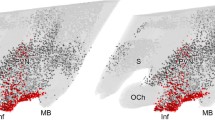Abstract
Male Wistar rats aged between 8 and 12 months were injected with 7–8 µl of aqueous L-leucine-14C (specific activity: 12543 megaBq/mM) in the region of the ventral horn at the level of segments L5,6 of the spinal cord. Radioactivity was investigated in 3 mm segments of the ventral roots concerned within 1 h in all series of experiments. Estradiol dipropionate, testosterone propionate, insulin, and small doses of thyroxine were found to accelerate axonal transport of labeled material, while hydrocortisone, large doses of thyroxine, as well as castration and thyroidectomy delayed this process. It was thus concluded that axonal transport is under clear-cut hormonal control.
Similar content being viewed by others
Literature cited
A. I. Gegel'gans, G. A. Gaidina, L. M. Gol'ber, et al., Thyroid Hormones. Biosynthesis, Physiological Effects, and Mechanics of Action [in Russian], Tashkent: Fan. (1972).
Ya. L. Germanyuk, "Impaired biosynthesis of nucleic acids and protein with long-term surplus of glucocorticoid hormones in the organism," in: Endocrinology, Zdorov'ya, Kiev, edition 6 [in Russian] (1976), pp. 59–65.
Ya. L. Germanyuk, The Role of Insulin in Biosynthesis of Nucleotides, Nucleic Acids, and Proteins [in Russian], Nauk. Dumka, Kiev (1973).
R. N. Glebov and G. N. Kryzhanovskii, "Axonal flow of substances during different physiological and pathological states of the nervous system," Usp. Sovrem. Biol.,82, No. 6, 417–436 (1976).
E. Davidson, "Hormones and genes," in: Cell Molecules, Vol. 2, [Russian translation], Mir, Moscow (1967), pp. 37–48.
V. S. Il'in, "Cellular and molecular mechanisms underlying central control of metabolism in higher organisms," in: Aspects of Theoretical Medicine [in Russian], Meditsina, Leningrad (1968), pp. 93–117.
D. Kennel, "Use of filters for separating radioactive RNA, DNA, and protein," in: Nuclei Acid Research Techniques [in Russian], Mir, Moscow (1970), pp. 157–186.
N. M. Kosmina, "Effects of hydrocortisone on parameters of energy metabolism in guinea pig brain tissue," Fiziol. Zh. [in Ukrainian],13, No. 4, 252–255 (1967).
A. N. Mezentsev and O. V. Messinova, "Axoplasmic transport and axonal biosynthesis processes," Usp. Sovrem. Biol.,72, No. 1 (4), 62–76 (1971).
N. P. Mertvetsov, Hormonal Control over Emergence of Genes [in Russian], Mir, Moscow (1986).
T. M. Mishunina and A. Ya. Mestechkina, "Inclusion of14C alanine in proteins and concentration of these in tissue of intact and adrenalectomized rabbits after hydrocortisone and corticotropin administration," Ukr. Biokhim. Zh.,52, No. 5, 587–592 (1980).
B. V. Pokrovskii, "Sex hormones," in: Hormonal Biochemistry and Control [in Russian], Nauka, Moscow (1976), pp. 246–299.
K. V. Fomichenko, "Pattern of change in brain protein metabolism produced by adrenalectomy and hydrocortisone administration," in: Hormones and the Brain [in Russian], Nauk. Dumka, Kiev (1969), pp. 72–74.
V. V. Frol'kis, S. A. Tanin, V. I. Martsinko, and O. K. Kul'chitskii, "Axoplasmic transport rate in ventral roots of the rat spinal cord during againg and its relationship with energy metabolism level," Neirofiziologiya,16, No. 2, 189–194 (1984).
N. A. Yudaev and B. V. Pokrovskii, "Anabolic and androgenic effects of methandrostenol in experiments on male rats," Vopr. Med. Khim.,12, No. 5, 527–532 (1966).
E. Chihara, "Axoplasmic and nonaxoplasmic transport along the optic pathway of albino rabbits: a theoretical pattern of distribution," Ophthalmol. Vis. Sci.,18, No. 5, 255–296 (1979).
M. Frizell and W. G. McLean, "The effect of triiodothyronine on axonal transport in regenerating peripheral nerves," Exp. Neurol.,64, No. 1, 225–230 (1979).
V. V. Frolkis, S. A. Tanin, V. I. Martsinko, et al., "Axoplasmic transport of substances in motoneuronal axons of the spinal cord in old age," Mech. Ageing Dev.,29, No. 1, 19–28 (1985).
N. Hosoya, D. Hagerman, and C. Viiles, "Stimulation of fatty acid synthesis by estradiol in vitro," Biochem. J.,76, No. 2, 297–301 (1960).
E. Jensen, "On the mechanism of estrogen action," in: Recent Progress in Hormone Research, Academic Press, New York; London (1962), pp. 387–408.
P. Keen, J. P. Robinson, D. R. Tomlinson, and G. B. Willars, "Axonal transport of substance P-like immunoreactivity in rats with long-term experimental diabetes," J. Physiol.,387, 39 (1987).
C. Marc and A. Rabie, "Microtubules and neurofilaments in the sciatic nerve fibers of the developing rat: effects of thyroid deficiency," Int. J. Dev. Neurosci.,3, No. 4, 353–358 (1985).
B. McEwen, A. Biegonn, P. Davis, et al., "Steroid hormones: humoral signals which alter brain cell properties and functions," in: Recent Progress in Hormone Research, Vol. 38, Academic Press, New York; London (1982), pp. 41–92.
W. G. McLean and K. F. Meiri, "Rapid axonal transport of protein in rat sciatic motor nerves during early experimental diabetes," J. Physiol.,301, 43–44 (1980).
S. Ochs, Axoplasmic Transport and its Relation to Other Nerve Functions, A. Wiley-Interscience, New York (1982).
P. J. Sheridan and F. J. Weaker, "The primate spinal cord is a target for gonadal steroids," J. Neuropathol. Exp. Neurol.,40, No. 4, 447–453 (1981).
J. Sjöstrand, "Rapid axoplasmic transport of labelled proteins in the vagus and hypoglossal nerves of the rabbit," Exp. Brain Res.,8, No. 2, 105–112 (1969).
J. R. Tata, "Inhibition of the biological action of thyroid hormones by actinomycin D and puromycin," Nature,197, No. 4873, 1167–1168 (1963).
J. R. Tata and C. C. Widnell, "Ribonucleic acid synthesis during the early action of thyroid hormones," Biochem. J.,98, No. 2, 604–620 (1966).
D. R. Tomlinson, G. B. Willars, and J. P. Robinson, "Prevention of defects of axonal transport in experimental diabetes by aldose reductase inhibitors," Drugs,32, No. 2, 15–18 (1986).
G. Weber, R. L. Singhal, N. B. Stamm, et al., "Synchronous behavior pattern of key glycolytic enzymes: glycokinase, phosphofructokinase and pyruvate kinase," Adv. Enzyme Regul.,4, 59–81 (1966).
S. J. Whiteley, J. Townsend, D. R. Tomlinson, and A. M. Brown, "Fast orthograde axonal transport in sciatic motoneurones and nerve temperature in streptozotocin-diabetic rats," Diabetologia,28, No. 11, 847–851 (1985).
Additional information
Institute of Gerontology, Academy of Medical Sciences of the USSR, Kiev. Translated from Neirofiziologiya, Vol. 22, No. 4, pp. 459–464, July–August, 1990.
Rights and permissions
About this article
Cite this article
Frol'kis, V.V., Tanin, S.A. & Martsinko, V.I. Effects of hormones on axonal transport rate at the ventral root of the rat spinal cord. Neurophysiology 22, 336–341 (1990). https://doi.org/10.1007/BF01052472
Received:
Issue Date:
DOI: https://doi.org/10.1007/BF01052472




